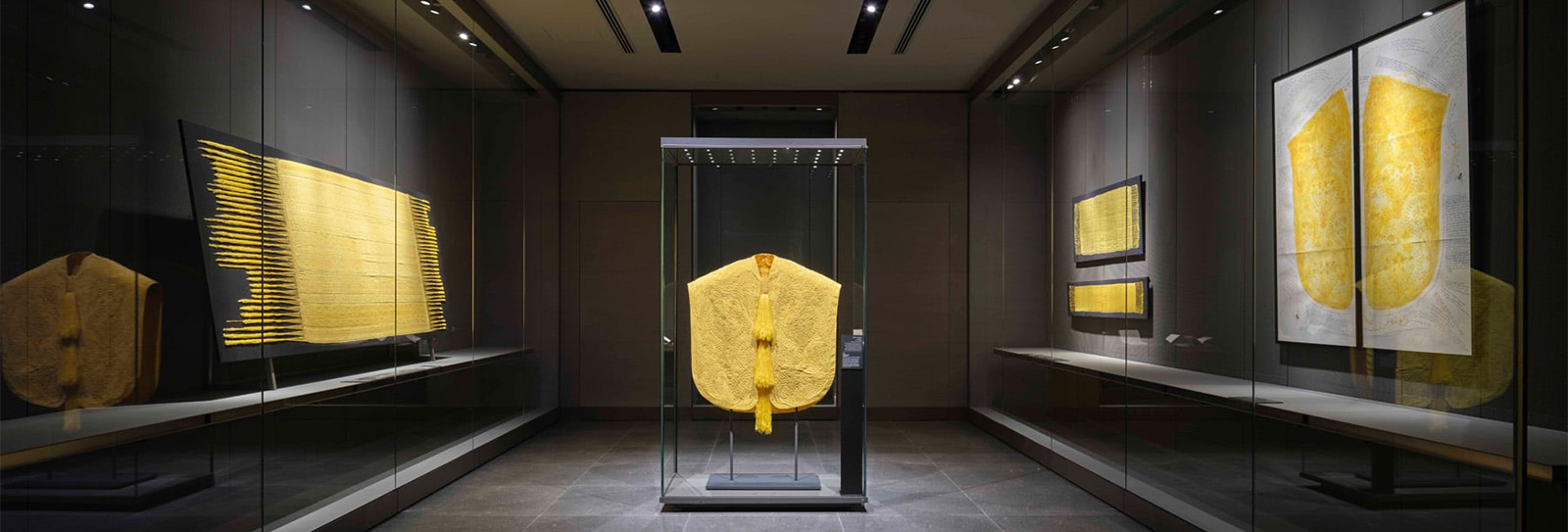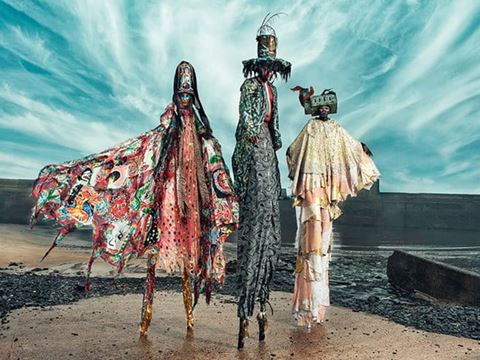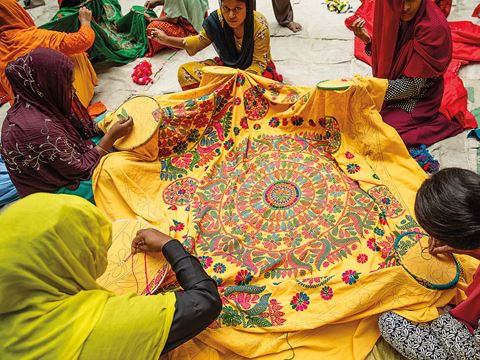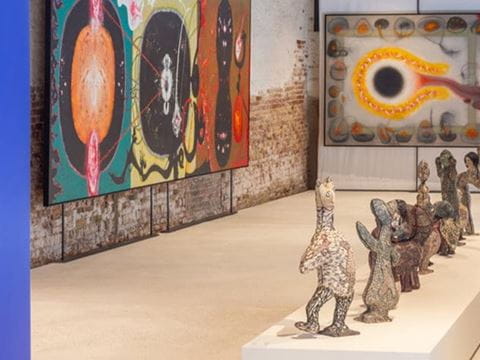
From 1.2 Million Spiders to Dreamy Cape: The Story of Silk as Art
Creators Simon Peers and Nicholas Godley present three exquisite textiles and a cape made from the silk of golden orb-weavers found in Madagascar.
Creators Simon Peers and Nicholas Godley present three exquisite textiles and a cape made from the silk of golden orb-weavers found in Madagascar.

If you’re a fan of the superhero Spider-Man or have dusted a cobweb or two, you’re already familiar with spider silk. It’s a fiber-rich protein that spiders use to catch their prey. Spider silk is unlike that of a Chinese silkworm; it has unique biodegradable properties, with incredible tensile strength, allowing it to stretch to 140% of its length without breaking, according to research at the University of the Pacific in California, United States.
For centuries, spiderwebs have served different purposes. The ancient Greeks used them as a wound dressing, and Pacific Islanders used them for fishing lines and nets.
The first mention of harvesting spider silk for weaving appears in 1621 in a work by the Italian professor of medicine Epifanio Ferdinando. The silk had been coveted for centuries for its promise of riches by those seeking to compete with silks arriving from China and flooding the wardrobes of wealthy Europeans.
Today, innovative laboratories globally are striving to synthetically reproduce the properties of spider silk, one of the strongest natural materials known, unlocking vast potential for industry and science.
The challenges of producing spider silk are enormous, and its cost has made the fabric rare. But in 2003, creators Nicholas Godley and Simon Peers decided to spend the better part of 20 years experimenting with the material. They created three exquisite textiles and an embroidered cape from the silk of golden orb-weavers found in Madagascar. One part was easy: The spiders’ silk is naturally gold, so no dyeing is required.
Typically, Godley and Peers say, it requires 600 to 1,000 spiders to produce just 1 gram of silk. The cape incorporates silk from 1.2 million spiders. It took more than two years to produce, including more than 6,000 hours of embroidery.

Their labors of love are currently on display at the Museum of Islamic Art in Doha, Qatar. The Golden Spider Silk exhibition showcases all four finished textiles together for the first time. They are the only examples of golden spider silk textiles in the world, and this is the first time that they are on display in the Middle East.
Where did the idea for the exhibition come from, and whose idea was it?
Simon Peers: We have to go back in time. I have lived in Madagascar for 35 years, where Nick and I first met, and I was involved in weaving when I stumbled across a story about people in Madagascar who had produced something with spider silk back in the 19th century. I thought that sounded like a made-up story, and then I discovered it wasn't. In the late 19th century, the French colonial government decided to try and produce something from spider silk, and they succeeded in producing these hangings for a four-poster bed. They were made from silk orb-weaver spiders, the Nephila madagascariensis. This bed was exhibited in Paris in 1900, and it sounded quite extraordinary. I thought it was irresistible to try and do it ourselves.

Despite its thinness, spider silk performs well under tension during weaving, exhibiting extraordinary elasticity and strength.
Why was it important to have it displayed in the Middle East?
Nicholas Godley: This is the first time that spider silk has been exhibited in the Middle East and before anywhere in Asia, where there is a long tradition of silk culture and textiles. We thought this was a great opportunity to share this incredible story with an audience who will appreciate the natural beauty of golden spider silk—and as an example of utilizing ingenuity to harness one of the most incredible biomaterials in the world. There is no question that the region, and specifically Saudi Arabia and Qatar, have placed an intense focus on innovation for the future, and it would be a perfect place to develop this unique biomaterial.
Why is this exhibition at the Museum of Islamic Art—is there a connection to the Muslim world? Peers: The exhibition is being shown at the MIA to coincide with the exhibition Fashioning an Empire, which, among other treasures, looks closely at the wonderful silk creations of Safavid Iran [dynasty from 1501–1736]. With silk as a theme, it seemed appropriate and opportune to run alongside this a small exhibition of another type of silk, the rarest of all.

Artist renderings of the spider and loom, left and center, and spools of spider silk, right, are featured in the museum display.
There is another connection: The imagery on the cape includes floral motifs of honeysuckle, hyacinths, roses, etc., which are inspired directly from fragments of Iznik tiles in the Blue Mosque, the Sultan Ahmed Mosque, in Istanbul. Many people have mentioned to us Surah Al-‘Ankabut(the Qur’an 29:41, The Spider) about [a] spider spinning a shelter. As in every culture, there is a real connection to the spider in the Muslim world.
What were the main challenges in creating this work?
Godley: There are different sets of challenges. The first was the sheer quantity, which was something we realized early on. We had to figure out how to transform it into different sizes of thread, different thicknesses. The other challenge was weaving, doing embroidery with this kind of material, as there isn’t a record of anybody really working with it before. These properties are very different to other materials, like using cotton. For example, you can't get water on it, as it starts to shrink. On the loom it behaves differently than regular silk.
What's the significance of the design of the textiles that are on display?
Peers: Of all four textiles on display, one can explain in a single phrase the significance of each: The medium is the message. This silk resonates in so many ways. For the two large textiles, the first one we made is based on the traditional royal textiles of the highlands of Madagascar. Since the spider is a genus particular to the country, it seemed entirely appropriate to create one of these textiles made from spider silk. It is a brocade weave with many geometric patterns depicting stylized flowers and maybe birds. The cape was made with the idea of producing a garment that would wrap around the body like a spider wrapping its prey in silk. The embroidered imagery works on various levels, mixing the nightmare and the poetry that is always associated with the spider and its web.

“There is no question that the region, and specifically Saudi Arabia and Qatar, have placed an intense focus on innovation for the future,” says Nicholas Godley, one of the textile creators, “and it would be a perfect place to develop this unique biomaterial.”
Why does this kind of work matter now?
Godley: We showed the world that something like this could be done. Everyone has said that natural spider silk cannot be mass-produced; we’ve proven them wrong. It is certainly a viable material. Funded start-ups have been competing with each other to figure out ways to produce a material that mimics the properties of spider silk because of its incredible properties. There’s a US company that produces artificial spider silk for bulletproof vests in Vietnam.
Peers: From my point of view, the most extraordinary thing we did was to produce something very beautiful and hopefully very interesting. Conceptually, it is extraordinary. It is laden with different sorts of ideas, tales, legends and myth. My approach to it was to try and produce, without sounding too grandiose, a work of art. Ultimately, they are creations in which the medium is the message.
Both Peers and Godley are modest about their achievements, but their talents have been recognized internationally. The Golden Spider Silk collection will be going to France for the first time early next year.
You may also be interested in...

African Artists gain traction in the UK
Arts
The United Kingdom is experiencing a surge in demand for contemporary art of African origin. For artists of the African diaspora, the UK represents a new arena in which to showcase their messages through unique techniques and mediums. Interest in their work follows mounting pressure on museums, universities and other institutions to “decolonize” their curricula and collections.
Nakshi Kantha Embroidery: Tales of Heritage and Revival
Arts
History
A traditional form of quilting in Bangladesh in which women embroider family history, love and memory into the fabric is blanketing markets locally and beyond.
The Resilience of Craft - Three Exhibitions at Venice Biennale Uphold Legacy of Traditional Arts
Arts
The Venice Biennale sheds light on lesser-known narratives outside of the international art world.